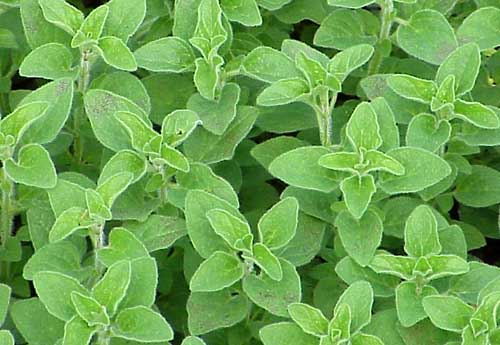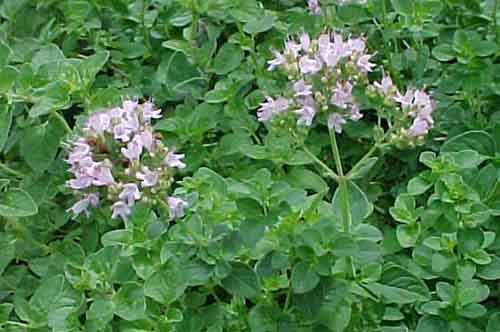A tough perennial plant, hardy to zone 5 with a very strong pungent aroma. Growing to 18 inches in height it usually has small white flowers has bright pink/purple flowers from June to August. It is very drought tolerant once established and likes bright sunny areas but can take some morning or afternoon shade. It can tolerate a wide pH range from 6.0 - 9.0. and likes a well drained soil. It is also fairly salt tolerant and will grow in gardens by the shore. It also makes a good container plant. Once established it takes very little care and can offer cheerful color with minimal maintenance.
Note: We sell three different kinds or Oregano, if intending for culinary use please choose the one that best fits your taste. Wild or Italian has a mild taste, Marjoram is stronger but still 'sweet' and Greek, which is very strong, and can sometimes be overpowering.
Description.
A hardy perennial that grows up to 18 inches tall and about 20 inches wide..
It has stiff woody stems that can be purplish in color. The stems are branched
and erect. The leaves are grayish green in color roughly oval in shape and hairy
on the undersides. They are arranged in opposite pairs on the stems and are
about one inch long. The flowers are produced in loose corymbs - slightly rounded
domes at the ends of the stems - these can be branched and often have smaller
flower clusters just beneath. Flowers are usually white but can be lilac, or
pink. Each flower is small fused together with three lobes at the base and one
at the top. Greek oregano does not usually flower as profusely as its counterparts.
They usually bloom from early to mid July through September. The whole plant
has a strong aroma. It is a creeping plant and will spread using rhizomes.
Location and Care
Greek Oregano needs lots of sunlight to flourish well, however it can tolerate
some shade in the morning or afternoon but may be a little straggly. It is very
happy in full sunlight and can tolerate fairly hot dry areas reasonably well.
However its not a really tough plant so its not for those really hot dry areas
where nothing else grows. It prefers a light soil with good drainage, with sandy
soil being ideal. It cannot easily tolerate heavy clay soils and does not like
a great deal of humidity so it may be harder to grow in areas where summers
are very humid of there is a lot of rain. For ideal growth it prefers moderate
fertile soil so adding some compost or good organic material is advised but
only sparingly as too much fertilizer can weaken the plant and reduce the aroma
and flavor. It can tolerate a wide pH range from 6.0 down to 9.0. but prefers
to stay above 8.0. Once established it needs very little water and is very drought
tolerant. It is hardy to zone 5.
The flavor of the plants tends to reduce with age so it is recommended that
they be replaced every 4-5 years. Ideally replacing a few plants every year
will ensure that there is always a supply of new fresh plants available. If
intending to harvest pinch off the flower heads as they appear to ensure a long
lasting supply of new fresh leaves.
Although not truly salt tolerant oregano will thrive in areas near the shore
so it is an excellent plant for shore side gardens. In fact many state that
the flavor of plants grown near the sea have a much stronger flavor than those
grown inland.
Growing Indoors
Oregano can also be grown indoors but it will need a sunny south facing window
to thrive. It makes a good house plant for those who often neglect their plants
as long as it has good light. Use a plastic pot to stop the plant drying out
too fast are reduce watering.
Water well but do not saturate the plant. Oregano
is fairly drought tolerant so can withstand a few missed waterings. Fertilize
once a month or use sustained release granules. Pinch off some of the new shoots
for use in the kitchen and to keep the plant bushy.
Growing.
The seeds can be sown directly in the ground when the soil has warmed enough
and all danger of frost has passed. However oregano grows very slowly and the
area will need to be constantly weeded to ensure new seedlings have a good start.
It is much easier to sow seeds indoors and plant out as large plant to avoid
extra work.
Start indoors at least six weeks before the last frost. Seeds usually germinate within 8-14 days depending on temperature and humidity. Make sure the seed trays have sufficient light and warmth, keep soil moist but not wet at all times. Transplant seedlings to individual pots when large enough to handle and grow on to plants at least three inches tall before planting outside. Transplant out after all danger of frost has passed. Space plants 14 - 18 inches apart.
Harvesting.
Leaves can be picked off the plant after it reaches at least six inches in height.
Pinch or snip off the growing tops of the branches rather than picking individual
leaves this encourages the plant to branch, become thicker and bushier and produce
more leaves.
For the most flavor and fragrance the best time to harvest oregano is just as
it begins to flower as the oils are at their highest at this point. If harvesting
for drying cut whole stems to within 1-2 inches from the ground. Do not cut
down the whole plant but leave some stalks to allow the plant to regenerate.
Stems can then be bunched and hung to dry then stored for later use. The flavor
and intensity of dried leaves is much strong than the fresh ones and it usually
preferred in cooking.
For continuous fresh leaf production pluck the fresh young shoot tops on a continuous
basis once the plant has reached at least six inches high. Cut only a few stalks
from each plant to ensure they have enough stems left to regenerate. The desired
oils reduce once the plant has flowered so pinch off the flower stalks as they
appear to ensure good quality leaf production.
Pests and diseases.
Oregano can be susceptible to aphids and leaf miners. IN hot dry situations
spider mites can be a problem. Root rot can set in of the plant is too wet.
Fungal diseases especially can be a problem in humid climates.
Uses.
As a culinary herb it provides a very strong pungent flavor to any dish and
is used a lot in Mexican, Italian and Greek cookery.
Greek Oregano is also used as a medicinal herb, and has been for centuries.
The leaves and flowering stems have a strong antiseptic effect and a tincture
of tea is used to treat colds, influenza, mild feverish illnesses, indigestion,
stomach upsets and painful menstruation. It is also a sedative and should not
be taken in large doses although mild teas have a restful soothing effect and
can help with sleep. A liniment using the herb is used to treat bronchitis,
asthma, arthritis and muscular pain. The essential oil can be used to relieve
toothache.







